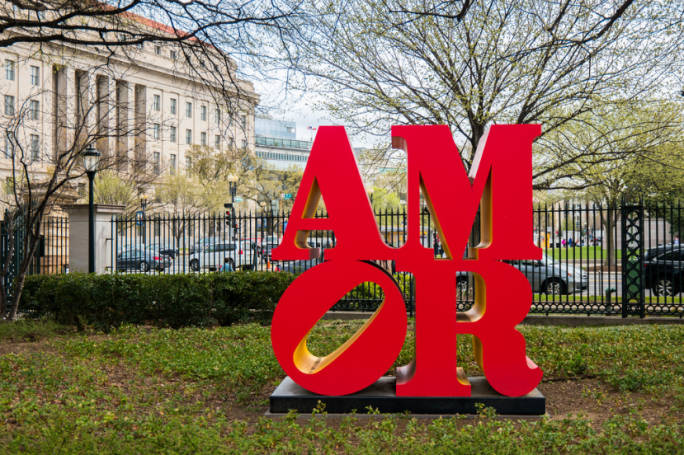
American Artist Robert Indiana. Photo: Lauren Caselberry, AP
Robert Indiana, one of the greatest artists of a generation has passed away at the age of 89. Indiana was a pop artist whose Love sculptures were some of the most recognisable artworks of the 20th century. His iconic yet playful work spanned a variety of media: from prints and paintings to public sculpture. To honor his legacy and contributions to American art, we take a look back at defining moments in his distinguished career.
Born in New Castle, Indiana, Robert Indiana grew up as Robert Clark (he wouldn't change his surname until several years later). His passion for the arts developed early. At the School of the Art Institute of Chicago, where he studied studio art on the G.I. Bill after three years in the Air Force, Indiana's interest in drawing quickly evolved to other art forms.

Robert Indiana, AMOR, conceived in 1998, executed in 2006, painted aluminum, National Gallery of Art, Washington
Photo: Flickr: Nan Palmero
Following his graduation from college, Indiana moved to New York in 1954 where he worked at an art supply store on West 57th street. It was at the art store that he met fellow artist Ellsworth Kelly with whom he would develop a mutually beneficial exchange of artistic influence and inspiration over several decades. This type of collaboration and openness with fellow artists shaped Indiana's career and reputation. Throughout his life he maintained close relationships with dozens of artists including Jack Youngerman, Agnes Martin, and Cy Twombly, with whom Indiana shared a studio.
Best known for forwarding pop art in the 60s and 70s, Robert Indiana's works revolved around monosyllabic words like Amor and Hug. In 1964, at the New York World's Fair, he installed a flashing 20-foot electric signed that read "Eat". Perhaps the world wasn't prepared for this type of groundbreaking use of popular signage... it was unplugged almost immediately because it drew too many people looking for food.
Indiana's most iconic image, LOVE, first gained widespread recognition when it was used on the Museum of Modern Art's 1965 Christmas card. The artwork was later turned into a 12-foot tall steel sculpture for the Indianapolis Museum of Art in 1970. In 1973, the image became ubiquitous when the United States Postal Service created a LOVE postage stamp. In fact, it was so popular that 300 million stamps were printed. This widespread appeal led Indiana to create more versions of the LOVE sculpture, many of which are on display around the world in public parks and squares.
Indiana welcomed the range of public perceptions and reactions that his work evoked, especially the large-scale public sculptures. Of course, this was part of the life of the object. There was, and still is, a sense of humour and lightheartedness that pervades his work. Consider the famous LOVE sculpture. Indiana famously claimed it as the 20th century's "most plagiarized work of art", and kept a collection of knockoffs in his home to prove it.

Robert Indiana, LOVE, 1971, painted aluminum. Photo: Wikimedia Commons; Hu Totya
Highly engaged and committed to social justice, Indiana was also known for his work for the Democratic National Committee. In 1976, he revamped the Love series to spell out the word "vote". The iconic and eye-catching work spread throughout the country, used by the DNC on posters and other campaign materials. During the 2008 presidential campaign, he re-purposed the work again in a show of support for Barrack Obama, changing the four letters to spell out "hope". The image was authorized for reproduction on T-shirts, buttons, and prints, helping Obama's presidential campaign in securing the vote.

Robert Indiana, HOPE, 2008, oil and silkscreen ink on canvas
Recent years have witnessed a critical reevaluation of Robert Indiana's work. His pop masterpieces were the subject of a retrospective exhibition at the Whitney Museum of American Art in 2013, Robert Indiana: Beyond Love, and are frequently exhibited as important parts of several major permanent collections throughout the world. While critics and curators seek to reappraise Indiana's oeuvre within the context of pop art, to fans around the world Indiana will always be remembered as the "architect of love."